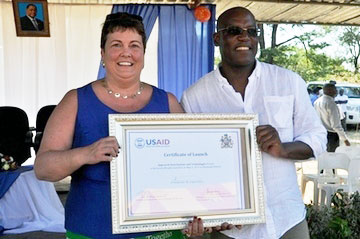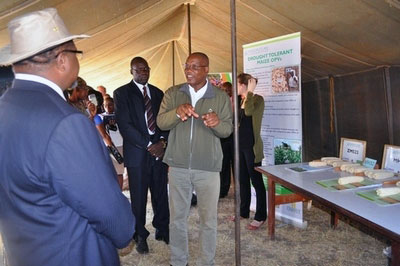On May 6, the United States Agency for International Development (USAID) and the Government of Malawi jointly launched five projects on food security, fisheries and environment. The USD-141-million-worth projects will be implemented by USAID in 13 districts over a five-year period.
These complementary projects are designed to work together to strengthen resilience to climate change, increase production and improve nutrition in targeted communities. The projects also connect with other USAID–Malawi activities in these areas.
More than 1,000 people attended the launch, representing farmer associations, USAID, local communities, non-governmental organizations, research institutions, Malawi government departments, seed companies, and CGIAR.
Officiating the launch held in Machinga District were Ms. Virginia Palmer, the United States Ambassador to Malawi; Dr. Allan Chiyembekeza, the Minister of Agriculture, Irrigation, and Water Development; and Mr. Bright Msaka, the Minister of Natural Resources, Energy and Mining.

Through the USD-21-million Feed the Future Malawi Improved Seed Systems and Technologies project, a consortium of agricultural research centers led by the International Crops Research Institute for the Semi-Arid Tropics (ICRISAT) is working to increase the supply and distribution of quality seed for maize, groundnuts, pigeonpeas, soybeans and sweet potatoes, and on developing an aflatoxin control product in seven focus districts in South-central Malawi. Other members of this consortium are CIMMYT, the International Potato Center, and the International Institute of Tropical Agriculture.
Partnerships for progress
Feed the Future is the U.S government’s global hunger and food security initiative.
ICRISAT and its partners are working closely with the Ministry of Agriculture, Irrigation, and Water Development. USAID support will promote the production and multiplication of breeder, basic and certified seed by skilled seed growers to ensure smallholder farmers have greater access to improved seed.
Winds of change in a changing world
Much of southern Malawi can no longer depend on traditional rain cycles in the face of climate change. Some districts, such as Machinga in the Southern Region, live under rain shadows – areas on the leeward side of the mountains where winds push the dry heat upward and drive promising rain clouds away, resulting in chronic droughts.
Ambassador Palmer’s speech focused on integrating development programs to enhance community resilience and lead to better outcomes. “We think this strong focus on co-location, coordination and collaboration will allow us to advance sustainable livelihood opportunities at a greater scale – and with greater impact – than would otherwise be possible.”
She also said this integration of USAID development projects in Malawi might soon become a model for development worldwide.
Seeds for needs, now and in the future
Dr. Peter Setimela, CIMMYT–Southern Africa Regional Office Seed Systems Specialist, observed: “To popularize drought-tolerant maize varieties, CIMMYT will support pre-basic and basic seed production, field days and demonstration plots to benefit smallholder farmers. We will support capacity building of both private-sector seed companies and government seed inspectors to improve overall quality and seed marketing in Malawi.”

At only 25 percent, use of improved seeds is still very low among smallholders in Malawi. Maize yields are below 2 tonnes per hectare, whereas there are varieties available that can yield as much as 10 tonnes per hectare.
Over the next three years, CIMMYT hopes to reach 50,000 households with drought-tolerant maize varieties. This will ultimately reduce poverty and help farmers adapt to the impacts of climate change.
A seed system in a well-linked value chain is very important and had been missing in previous development efforts in the country.
“The design of the Improved Seed Systems and Technologies Project addresses these issues. My ministry is also keen to further work with the US government to ensure that these research activities reach Malawi’s smallholder farmers,’’ said Dr. Chiyembekeza.
In a country where more than half the population lives below the poverty line, the Southern Region has the highest percentage of poor households. Malawians are mainly farmers, and with 85 percent of the population depending on rain, these recurring droughts make it harder to feed the family – nearly one-quarter of Malawians cannot meet their daily food needs.
 Climate adaptation and mitigation
Climate adaptation and mitigation